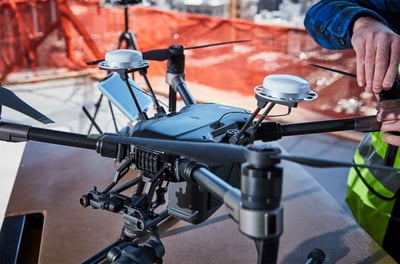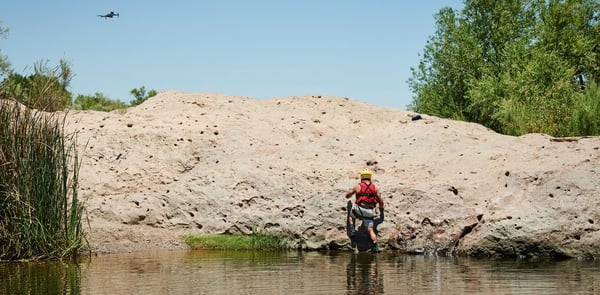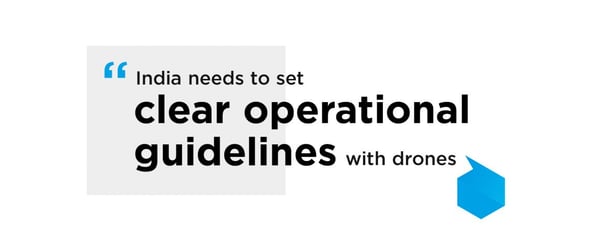As India’s technology sector grows into the first ranks of global leadership – creating new jobs, businesses, and innovations – one key industry is being held back. It’s not because India doesn’t have the talent, experience, or equipment to compete. It’s because India’s regulations are currently hampering progress.
The industry is drone technology. As you’ve learned in other ViewPoints articles, drones are being used to conduct surveys and inspections from the air, improving agricultural yields, as well as helping businesses save money and do their work better, faster, and safer. Universities, NGOs, and government agencies are all exploring how drones open up new possibilities for research, resource management, and public safety. Drones are also estimated to generate billions of dollars in economic activity and have rescued more than 292 people during emergencies.
Despite India’s robust ecosystem of hardware engineers, software developers, and university educators, its drone sector is hindered by some of the most rigorous flight restrictions in the developed world. Countries with more flexible drone laws have seen their industries blossom while protecting public safety. Yet India is falling behind in the adoption and deployment of life-saving drone technologies. This is partly due to delays in implementing its own policies, but also due to the nature of the policy itself.
India’s drone policy was introduced in August 2018 by the Directorate General of Civil Aviation. In parallel, the government initiated the development of a Digital Sky system that requires every drone pilot to gain permission to fly in advance before every flight – a policy known as “No Permission, No Takeoff” (NPNT). The digital portal that’s supposed to process those permissions is a year behind schedule and is now expected to be ready in May 2020. However, even if the system was ready, it will prove more of a burden to the industry than a boon. The drone industry won’t be able to thrive if drone operators must apply 24 hours in advance to obtain permission before every flight.
 Other countries with thriving drone sectors have taken an approach that encourages the adoption and use of drone technology. The United States, the United Kingdom, China, Australia, and the European Union have set rules allowing drones to fly safely under clear operational guidelines. As a result, people in those countries routinely use drones to inspect hard-to-reach infrastructure, quickly survey construction sites and public lands, monitor environmental conditions, assist rescue squads, and much more. The rapid growth of the drone industry has resulted in new investments in drone startups, exciting drone applications being developed, and jobs and businesses created.
Other countries with thriving drone sectors have taken an approach that encourages the adoption and use of drone technology. The United States, the United Kingdom, China, Australia, and the European Union have set rules allowing drones to fly safely under clear operational guidelines. As a result, people in those countries routinely use drones to inspect hard-to-reach infrastructure, quickly survey construction sites and public lands, monitor environmental conditions, assist rescue squads, and much more. The rapid growth of the drone industry has resulted in new investments in drone startups, exciting drone applications being developed, and jobs and businesses created.
NPNT places heavy restrictions on the location, flight path, and time for operating drones, including a color-coded system for how and where drones can fly. Densely populated areas – where drones can do the most good – are likely to be classified as red No-Fly Zones. Most estimate that 50% of the landmass in India will become a No-Fly Zone.
This means that even the most experienced and responsible drone operators will need to apply for approval 24 hours in advance before they can photograph a wedding, survey their own construction site, or inspect a transmission tower. If they need to move to another location, wait for bad weather to pass, or accommodate an unexpected obstacle, they will need to apply for approval all over again. These same pilots won’t be able to operate in over half of Indian airspace.
In the past, first responders have used drones for search and rescue operations during disasters, helping to save hundreds of lives in the aftermath of the 2015 Nepal earthquake and floods in Kerala (2018), Uttarakhand (2013), and Chennai (2015).
The current law will make these life-saving activities harder to accomplish. Police, fire, and search and rescue operations would also be beholden to this system and require permission before undertaking life-saving missions. Regulations should help encourage beneficial uses like those mentioned above; instead, NPNT discourages them.

DJI is the world’s largest manufacturer of personal and professional drones, and we would very much like to partner with key stakeholders to help develop India’s promising drone ecosystem. Our products are used safely all over the world to open up new vistas, make dangerous jobs safer, allow farmers to improve yields, enable automated solutions for time-consuming tasks, and even save lives. However, after careful analysis of the policy and its impacts and costs, DJI has decided that we cannot introduce the majority of our products to India until regulators re-evaluate Digital Sky.
We agree with India’s primary goal of ensuring drones are safely integrated into the airspace, but this would be better served by converging on the global norms being set in Europe, the U.S. and other Asian countries.

addressing fundamental issues like how and when they can fly in controlled airspace or how close they can be to people. Other countries are tackling those issues directly, and India can too.”
We suggest that policymakers provide immediate blanket exemptions to most government agencies, especially police officers, firefighters, and rescue services. Their need for drones is sometimes a life-or-death matter, and we can trust them to fly safely and follow all established rules, as they do when conducting operations on the ground.
We also believe India should exempt drones that weigh less than 1 kilogram from NPNT since they pose minimal safety or security risks. Drones weighing 1 kilogram or more should be required to declare their flights to the government – call it “No Notification, No Takeoff” – so security forces can monitor them in real time.
Geofencing, Remote ID, and other tracking technologies are already available and come far closer to providing the security assurance the Indian government rightly seeks.
At DJI, we lead the industry in developing drone safety solutions. Our drones include GPS-based geofencing to keep them away from airports, prisons, military bases, and other sensitive locations. Our remote identification system allows police and airport officials to monitor drones usage in those areas and immediately locate their pilots. Our new commitment to install helicopter and airplane detectors in consumer drones will ensure drone pilots stay clear of other aircraft. These measures have helped make drones a remarkably safe technology.
Our proposed changes are suitable for the entire industry, and more importantly, for everyone in India who can benefit from a robust drone industry – from university engineers to rural farmers to urban rescue squads. It’s time for the government to modify Digital Sky so it can preserve safety while allowing India to reap the benefits of drone technology.

